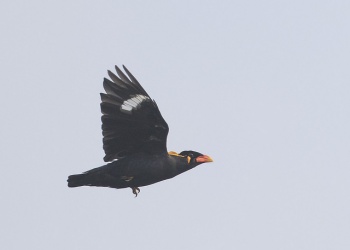- Gracula religiosa
Identification
30cm (11.0 - 11.8 in). A large, black myna.
- Bare yellow patch below eye and line of bare yellow skin behind eye backwards around nape, extending into two pendulous wattles
- Mostly black plumage with some purple gloss and turquoise to bronzy sheen
- Black wing with white patch
- Brown eye
- Orange to red bill
- Chrome-yellow legs
Sexes similar. Juveniles are less glossy and have smaller wattles.
Distribution
Found from the Indian Subcontinent east over Burma to Indochina, southern China, Malaysia, Sumatra, Borneo, Java and other islands of Indonesia.
Introduced populations in Florida, Puerto Rico and Hawaii. Other introductions failed, eg on Christmas Islands. Also reported in Taiwan.
Common in parts of its range. Some subspecies have a very small range and are poorly studied.
Taxonomy
Southern Hill Myna, Nias Hill Myna, Enggano Hill Myna and Tenggara Hill Myna have formerly been included in this species.
Subspecies
Clements recognizes nine subspecies[1], however, two of these are recognized as full species by IOC[2] and in the Opus.
- G. r. peninsularis
- East-central India (Orissa)
- G. r. intermedia
- G. r. andamanensis
- G. r. religiosa
- Malay Peninsula, Sumatra, Simeulue, Bangka, Borneo, Java, Bali, and Kangean and Bawean (Java Sea)
- G. r. batuensis
- Batu and Mentawi Is. (off west Sumatra)
- G. r. palawanensis
- Palawan, (Philippines)
- G. r. miotera
- Simeulue (off the west coast of Sumatra); probably extinct in the wild
Habitat
Woodland, evergreen or deciduous forest, forest edge, also disturbed areas (with some large trees remaining). Occurs from the lowlands up to the hills, locally up to 2000m on the Indian Subcontinent.
Behaviour
Usually seen in pairs or small groups.
A resident species. Some local movement may occur.
Diet
Feeds mainly on fruit and nectar. Takes sometimes also insects and other small animals (up to small lizards).
Breeding
Breeding season differs through range, may breed up to three times per year. A monogamous species.
The nest is made of small twigs, leaves and feathers and placed in a tree hole, usually at least 10m above the ground. May nest in association with other species like Vernal Hanging-Parrot. 2-3 light blue to blue-green eggs with brown to lavender spotting are laid; incubation by both sexes for 13–17 days; parental care by both adults; young fledge at 25–28 days; post-fledging care is minimal.
Brood parasitism by Common Koel recorded.
References
- Clements, J. F., T. S. Schulenberg, M. J. Iliff, T. A. Fredericks, J. A. Gerbracht, D. Lepage, S. M. Billerman, B. L. Sullivan, and C. L. Wood. 2022. The eBird/Clements checklist of Birds of the World: v2022. Downloaded from https://www.birds.cornell.edu/clementschecklist/download/
- Gill, F, D Donsker, and P Rasmussen (Eds). 2023. IOC World Bird List (v 13.1)_red. Doi 10.14344/IOC.ML.13.1. http://www.worldbirdnames.org/
- Del Hoyo, J, A Elliott, and D Christie, eds. 2009. Handbook of the Birds of the World. Volume 14: Bush-shrikes to Old World Sparrows. Barcelona: Lynx Edicions. ISBN 978-8496553507
Recommended Citation
- BirdForum Opus contributors. (2025) Common Hill Myna. In: BirdForum, the forum for wild birds and birding. Retrieved 13 May 2025 from https://www.birdforum.net/opus/Common_Hill_Myna
External Links
GSearch checked for 2020 platform.1





